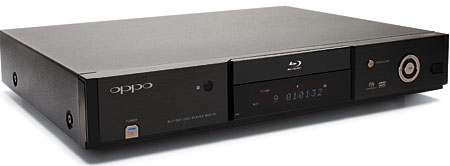Oppo BDP-83 Universal Blu-ray Player Page 3
The BDP-83 supports HDMI’s Deep Color specification, but there’s currently no native Deep Color program material on the market to take full advantage of it. All of today’s consumer sources, either SD or HD, are limited to 8 bits per color (times three colors, for a total of 24 bits of data per pixel). Thanks to the ABT chipset, the Oppo lets you select an 8-, 10-, or 12-bit output (per color) through the HDMI Deep Color menu—even for today’s sources. The extra bits are essentially upconverted. They do not provide true Deep Color, which would require material with a higher native bit rate. But if your display also supports 10- or 12-bit Deep Color operation, the upconversion can provide extra precision for display enhancements and color space conversion. This avoids potential rounding errors in the video signal path that can occur during the conversion back to 8-bit depth.

Another perk that Blu-ray players haven’t supported before is a zoom mode and scaling for a constant-height or anamorphic projector setup. The BDP-83 does the vertical squeezing to properly display via a projector with an anamorphic lens, which eliminates the need for a video processor for the scaling. I don’t have an anamorphic setup myself, so I was unable to test this feature.
Another big plus is the BDP-83’s inclusion of the Spears & Munsil High Definition Benchmark Blu-ray Disc. (See Home Theater University on page 16.) This disc has outstanding demo material sourced from a 4K camera (downconverted to 1920 by 1080 for the Blu-ray transfer). Plus, it gives you an incredible set of test tools to make sure your display chain is set up correctly and evaluate its performance, with clear guidance for every test. While some people don’t see the benefits of different player designs, this disc can highlight how the BDP-83 improves on the video processing that most Blu-ray players offer. This disc is also one of the references we use in our own testing. You can directly compare your results with ours and perform your own tests with other players you may have lying around.
Audio Processing
Over the last year, there’s been a big change in the Blu-ray player market. It wasn’t very long ago that there was a big disparity in Blu-ray hardware profiles. Some players offered BD-Live, and some only offered basic playback and possibly Bonus View compatibility. The more recent crop of players seem to have this locked down. Now the market is differentiating itself with expanded playback capabilities like YouTube and Netflix streaming, along with a host of other Internet streaming capabilities. But one area that hasn’t gotten any real attention is the universal player market.
In the latter days of DVD playback, shortly before the dawn of HD players, universal players that could also play back multichannel music via SACD and DVD-Audio in addition to DVDs and CDs were all the rage. Those who got a taste of high-resolution multichannel music usually became hooked, despite dwindling software support for those formats. While neither format expanded beyond a niche of dedicated enthusiasts, new SACD offerings still hit the market regularly, although they’re typically from smaller classical and jazz labels.
The BDP-83 offers full playback of both of these high-resolution music formats, including native DSD output via HDMI. The Oppo is one of a very few players that can output SACD as a native DSD data stream (DSD is the digital encoding format that SACD uses), and only a few surround processors and A/V receivers can accept it in that form. The Oppo can also convert the DSD stream to a linear PCM output, which most up-to-date surround processors and AVRs can handle. You can adjust the maximum PCM sampling rate to ensure that the digital output is compatible with the rest of your A/V chain. The BDP-83 can also convert the native DSD or converted PCM version to analog and route it to its 7.1-channel outputs.
Those analog outputs have full bass management and time alignment. The distances are set in pairs, so odd configurations (for example, mains that are different distances from the sweet spot) may be an issue. The BDP-83’s Small speaker setting uses a fixed crossover of 80 Hz. Unfortunately, there’s no test tone for level calibrations, so if you plan to use the analog outputs, make sure you have a disc with test tones.
Oppo is also working on Dolby Pro Logic II processing, a feature that’s normally reserved for AVRs and audio processors. This will be a nice perk if you don’t have this feature in your receiver and want to derive 5.1 sound from a stereo source.
- Log in or register to post comments






























































